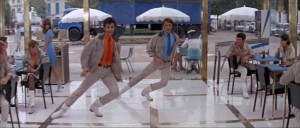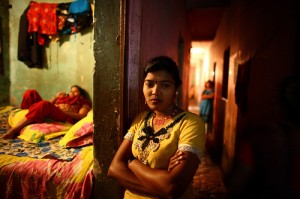Written for the Criterion dual format (Blu-ray & DVD) edition of The Young Girls of Rochefort, released in a box set, “The Essential Jacques Demy,” in July 2014. This essay is also posted on Criterion’s web site. — J.R.

Braque, Picasso, Klee, Miro, Matisse . . . C’est ça, la vie.
— Maxence in The Young Girls of Rochefort
Life is disappointing, isn’t it?
— Kyoko in Yasujiro Ozu’s Tokyo Story



Broadly speaking, Jacques Demy’s The Young Girls of Rochefort (1967) is loved in France but tends to be an acquired taste elsewhere. From a stateside perspective, its launch in the U.S. in April 1968 was relatively inauspicious and uncertain. In the New York Times, Renata Adler began her two-paragraph notice by saying, “The Young Girls of Rochefort, a musical that opened at the Cinema Rendezvous, is another of those strange, offbeat movies produced by Mag Bodard in which a conventional, gay form is structured over what would be, in its terms, a catastrophe.” (The three other Bodard films she had in mind were Agnès Varda’s Le bonheur, Michel Deville’s Benjamin, and Demy’s previous film, The Umbrellas of Cherbourg. Read more
From the Chicago Reader (February 24, 2006). I was shocked and upset to learn that Michael Glawogger, the visionary Austrian filmmaker and world traveler, died from malaria in Liberia at age 54. The film of his that left the most lasting impression on me was the remarkable Megacities (1998, see first still below), which filmed people living on the edge in Mumbai, New York City, Moscow, and Mexico City — the first part of an epic documentary trilogy that was followed by Workingman’s Death (2004) and Whores’ Glory (2011, see second still below). I’m sorry to say that this capsule review below is the only time I had occasion to write about his work. — J.R.



In Megacities (1998), Austrian filmmaker Michael Glawogger emulated the city symphony films of the 1920s, and for this 2005 documentary about manual labor around the world he also references film history with clips from Dziga Vertov’s Enthusiasm and Georges Franju’s Blood of the Beasts during the opening credits. Glawogger shoots coal miners in the Ukraine and sulfur miners working a volcanic crater in Java, the slaughter and rendering of goats and bulls in Nigeria, and the dismantling of tankers in Pakistan, emphasizing the workers’ small talk along with their physical activities. Read more
DVD AWARDS 2014
XI edition
Jurors: Lorenzo Codelli [absent from photo], Alexander Horwath, Mark McElhatten, Paolo Mereghetti and Jonathan Rosenbaum, chaired by Peter von Bagh

BEST SPECIAL FEATURES ON BLU-RAY:
LATE MIZOGUCHI – EIGHT FILMS, 1951-1956 (Kenji Mizoguchi, Japan) – Eureka Entertainment

The publication of eight indisputable masterpieces in stellar transfers on Blu-Ray is a cause for celebration. If Eureka is not exclusive in offering these individual titles, what makes this collection especially praiseworthy and indispensable is the scholarship, imagination and care that went into the accompanying 344-page booklet. Over 60 rare production stills are included, many featuring Mizoguchi at work. Striking essays by Keiko I. McDonald, Mark Le Fanu, and Nakagawa Masako are anthologized along with extensively annotated translations of some of the key sources of Japanese literature that inspired some of Mizoguchi’s late films. The volume closes with tributes to the great director written by Tarkovsky, Rivette, Godard, Straub, Angelopoulos, Shinoda, and others. Tony Rayns provides spoken essays and some full-length commentaries.
BEST SPECIAL FEATURES ON DVD:
PINTILIE, CINEAST (Lucian Pintilie, Romania) – Transilvania Films

An impeccable collection devoted to eleven films by an important and neglected maverick Romanian filmmaker, masterful and acerbic, with invaluable contextualizing extras concerning his life, work, and career drawn from ten separate sources. Read more








